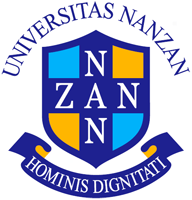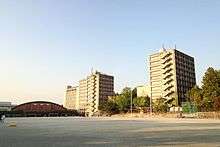Nanzan University
| 南山大学 | |
 | |
| Motto | Hominis Dignitati (人間の尊厳のために Ningen no Songen no Tame ni, "For human dignity") |
|---|---|
| Type | Private |
| Established | 1949 |
| President | Rev. Fr. Dr. Michael Calmano, S.V.D. |
Academic staff | 314[1] |
| Students | 9,292[1] |
| Location | Nagoya, Aichi Prefecture, Japan |
| Campus | Urban/Suburban |
| Affiliations | Nanzan Gakuen |
| Website | www.nanzan-u.ac.jp |
Nanzan University (南山大学 Nanzan daigaku) is a private, coeducational Catholic university located in Aichi Prefecture, Japan. The main campus is in the Shōwa Ward of Nagoya City, with another in Seto City and a recently established satellite campus near Nagoya's Takaoka Station on the subway Sakura-dōri Line. It is considered to be one of the most prestigious private universities in Central Japan. [2]
History
Nanzan is named after the forested mountains near Goken'ya-chō (五軒家町), known as Minamiyama (南山), which literally means "southern mountain". The on reading for "南山" is Nanzan. Also, in Chinese poetry "南山" refers to Mount Lushan until the Tang Dynasty and Mount Zhong Nan thereafter. Notably, the word appears in the classical poetry collection Shi Jing and the works of famous poet Li Bai. Thus, the choice of name is a celebration of longevity, perseverance, and prosperity for both the school and its alumni.[3]
Divine Word Missionary Josef Reiners founded Nanzan Junior High School in 1932. Nanzan Foreign Language School was added to the Nanzan system in 1946 and eventually renamed Nanzan University in 1949. In 1995, Nagoya Seirei Junior College was subsumed by Nanzan when the two schools' organizations merged.[4] In 2008, Nanzan plans to open an elementary school, officially named Nanzan University Affiliated Elementary School.

In 1961, Czech architect Antonin Raymond was commissioned to design most buildings on the Nagoya campus. It was one of the largest projects that he would undertake. The campus was orientated on a north–south axis across rolling hills and the eight buildings were arranged to suit the typography and harmonise with the landscape. In-situ concrete is used throughout the scheme and each building has its own concrete form, some with pilotis, others with shells.[5]
Located to the east of the campus is the Divine Word Seminary Chapel, constructed in 1962. This is a building that exploits the plastic capacity of concrete, with two intersecting shells forming a bell tower. These are punctured with vertical slots which allow light to radiate along the curved interior walls.[6]
Nanzan Junior College (南山短期大学 Nanzan Tanki Daigaku) opened in 1968 as a women's junior college affiliated with the University. In 2011 the junior college campus was closed and reorganized as a department on Nanzan University's Nagoya campus offering courses in English language.[7]
Organization
Nanzan University is part of Nanzan Gakuen (南山学園 Nanzan gakuen), an educational complex of three high schools, a women's junior college, and the university itself. Among coeducational universities, Nanzan is the only Catholic missionary school in the Chūbu region.
Nanzan has a strong international focus, actively pursuing foreign exchange students. Western students primarily attend the Nagoya campus, while Asian students attend the Seto campus.
For many years, Nanzan has held an annual competition with its Catholic sister schools Sophia University (上智大学 Jōchi daigaku) and Sapientia University (英知大学 Eichi daigaku), primarily focusing on athletics. Combining the first two syllables in Japanese of the respective schools, the Nanzan-Sophia event is known as the Jōnan-sen (上南戦), while the Sapientia-Nanzan event is known as the Einan-sen (英南戦).
The humanities department offers priest training courses through its Christian studies curriculum.
Campuses

.jpg)

Nagoya
Nanzan's main campus is in Yagoto, the east of Nagoya, in Shōwa-ku. The Nagoya campus is home to the Faculties of Humanities, Foreign Studies, Economics, Business Administration, and Law. The campus is about a 10-minute walk from either Nagoya Daigaku (名古屋大学) or Yagoto Nisseki (八事日赤) station on the Nagoya Municipal Subway's Meijō Line. Alternately, campus is a 15-minute walk from Irinaka (いりなか) on the subway's Tsurumai Line.
Seto
The Seto campus houses the Faculties of Policy Studies, and Mathematical Sciences and Information Engineering. It can be reached by taking the Linimo magnetic levitation train to the former station of the Aichi Expo, now known as the Expo Memorial Park Station (愛・地球博記念公園駅 Ai/chikyūhaku kinen kōen eki). From there, campus is 10 minutes by school bus.
Faculties and Departments
- Humanities
- Christian Studies
- Anthropology and Philosophy
- Psychology and Human Relations
- Japanese Studies
- Foreign Studies
- British and American Studies
- Spanish and Latin-American Studies
- French Studies
- German Studies
- Asian Studies
- Economics
- Business Administration
- Law
- Policy Studies
- Mathematical Sciences and Information Engineering
- Information and Telecommunication Engineering
- Mathematical Sciences
Graduate Schools and Programs
- Humanities
- Christian Thought
- Religious Thought
- Anthropology
- Educational Facilitation
- Linguistic Science
- International Area Studies
- Economics
- Business Administration
- Business Administration
- Management
- Law
- Policy Studies
- Mathematical Sciences and Information Engineering
Notable Alumni and Students
- Ryohei, R&B singer
- HOME MADE KAZOKU, hip hop trio
- Sakon Yamamoto, racecar driver (currently enrolled)
- Kazuki Nakajima, racecar driver (currently enrolled)
Affiliations
Nanzan is a member of the ASEACCU (Association of Southeast and East Asian Catholic Colleges and Universities), an organization of Catholic institutes of higher learning in the Philippines, Australia, Thailand, Taiwan, South Korea, Indonesia and Japan. In addition to Nanzan, there are seven other Japanese members, including Sophia.
Sister Schools
- Sophia University
- Sapientia University
- Toyota Technological Institute
Associated Schools
- Nanzan Elementary School
- Nanzan Boys' Junior and Senior High School
- Nanzan Girls' Junior and Senior High School
- Nanzan International Junior and Senior High School
- Seirei Girls' Junior and Senior High School
See also
Close by to the main campus is the Showa Museum of Art.
References
- 1 2 "A Brief Statistical Look at Nanzan Gakuen". Retrieved 2008-03-23.
- ↑ http://auabroad.american.edu/index.cfm?FuseAction=programs.ViewProgram&Program_ID=10515
- ↑ "Nanzan University Founding Principles". Retrieved 2007-04-21.
- ↑ "Nanzan University Children of the Light". Retrieved 2007-04-20.
- ↑ Japan Architect (2005), p124
- ↑ Helfrich & Whitaker (2006) p74
- ↑ 南山短期大学の名称変更、キャンパス移転および定員変更について [Concerning Nanzan Junior College's name change, campus closing, and transfer of personnel] (in Japanese). Retrieved 2013-09-27.
External links
| Wikimedia Commons has media related to Nanzan University. |
Coordinates: 35°08′53″N 136°57′47″E / 35.1481°N 136.963°E